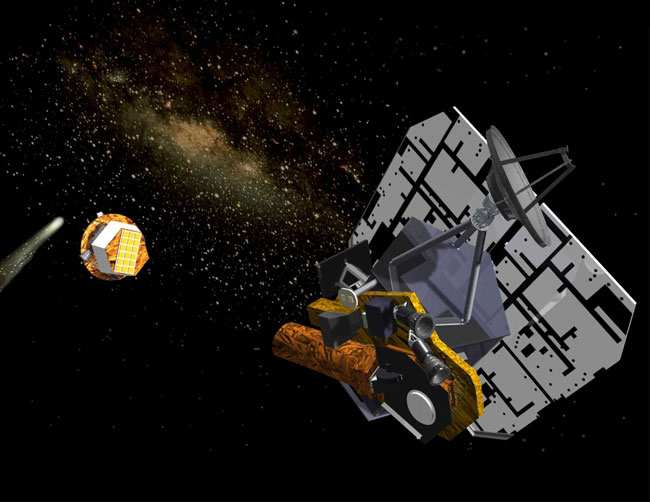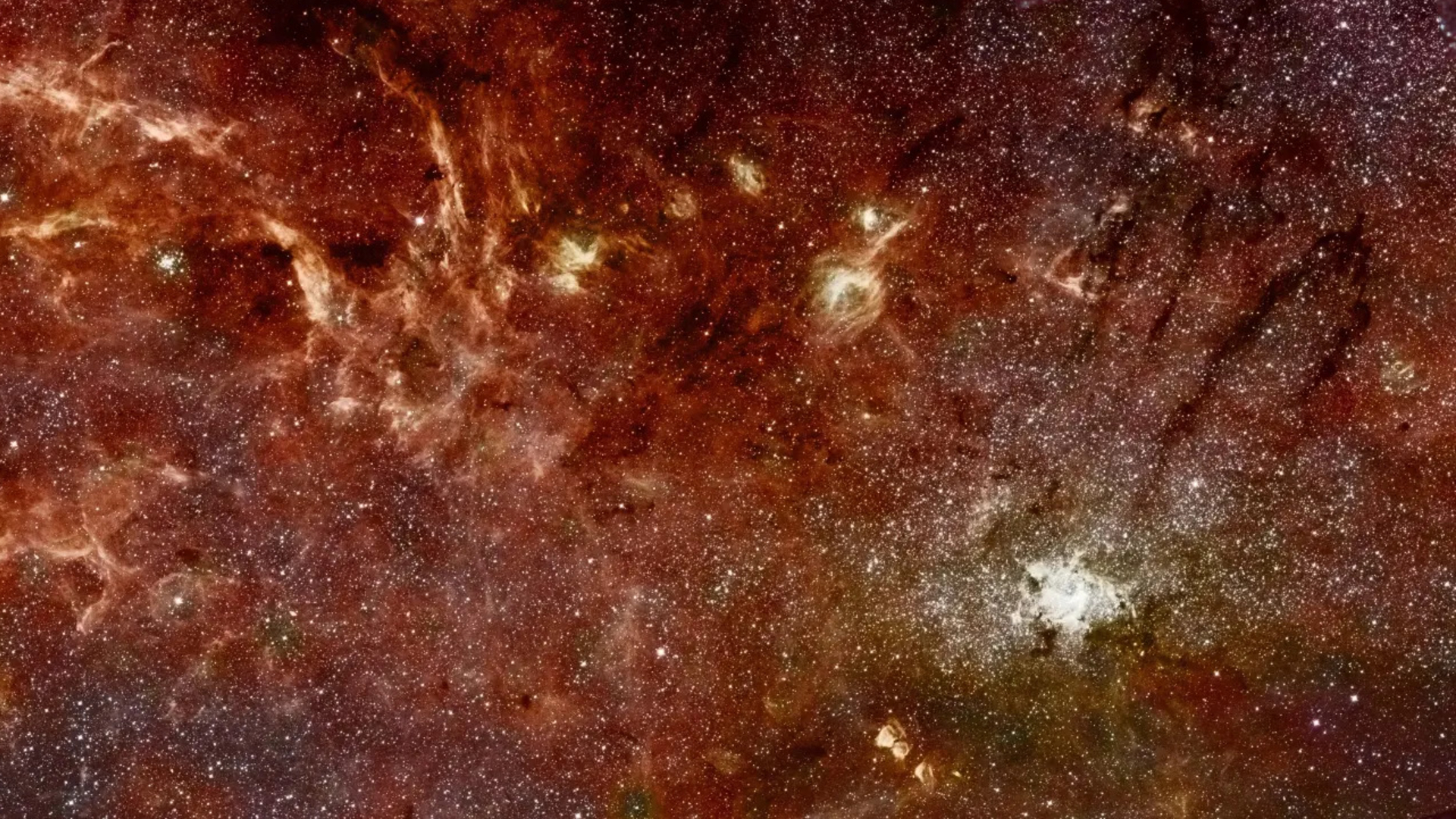Beyond Deep Impact: Possible Targets After Fireworks

BOULDER, Colorado -- Deep Impact's scheduled run-in with a comet this holiday weekend may not be a one hit wonder. Scientists are studying other potential targets after the spacecraft completes its dramatic mission at Comet Tempel 1.
The main mission for the NASA craft is to create celestial fireworks early Monday morning (late Sunday in western United States). A "Flyby" vehicle will deploy an "Impactor" probe for the hit-and-run encounter. The Impactor that thumps into Comet Tempel 1 is likely to vaporize upon impact. The kinetic energy of the collision is expected to create a crater the size of a football field and propel material from the comet's nucleus into space.
From its vantage point several hundred miles away, the Flyby spacecraft will use its telescopes, cameras and spectrometer to monitor the impact, all in an effort to study what's underneath the comet's icy surface.
Then the Flyby spacecraft might be retargeted to another faraway comet.
High-tech checkup
"We've been working on an extended mission," said Monte Henderson, Deputy Director of Programs in Civil Space Systems for Ball Aerospace & Technologies Corporation here. The company designed and built the two-part spacecraft specifically for the Deep Impact mission.
Depending on the overall health of Deep Impact's Flyby spacecraft after monitoring Comet Tempel 1, a go/no-go decision can be made to send it on a 3.5 year cruise to Comet Boethin.
Breaking space news, the latest updates on rocket launches, skywatching events and more!
That object orbits the Sun every 11 years. It was discovered on January 4, 1975 during a routine comet-hunting session carried out by the now deceased Reverend Leo Boethin of the Philippines.
Henderson told SPACE.com that shortly after Deep Impact's slam-dunk with Comet Tempel 1, engineers will give the Flyby spacecraft a high-tech checkup. Particular attention will be paid to how much dust and debris that spews out from the comet has hit the Flyby craft.
Will instruments onboard the Flyby spacecraft remain in tip-top shape? Or have their optics been sandblasted?
Potential damage
The Flyby spacecraft -- nearly as large as a Volkswagen Beetle -- carries two of the three primary instruments, the High Resolution Instrument (HRI) and the Medium Resolution Instrument (MRI), for imaging, infrared spectroscopy, and optical navigation.
Debris shielding is a key part of the Flyby spacecraft's design.
As the spacecraft passes through the inner coma of Comet Tempel 1 it is in danger of being struck by small particles that could damage the control, imaging and communication systems.
To minimize this potential damage the Flyby spacecraft is rotated before it passes through the inner coma. That debris shielding should provide, it is hoped, complete protection to the flyby spacecraft and its instruments.
The spacecraft's main deck serves as a back wall and an aluminum shield protects the Flyby spacecraft.
Fuel budget
"After the encounter, we'll do a mini-commissioning of the Flyby spacecraft," Henderson said. If the reassessment is positive, a good portion of the remaining fuel on the Flyby vehicle will be used to put it on a 3.5-year jaunt to reach Comet Boethin. The redirecting maneuver would need to occur sometime before July 24, he said.
"If we don't have good solid science instruments to use at Comet Boethin, we probably wouldn't want to expend our entire fuel budget. It would be more prudent to step back and figure out what else can we do," Henderson said.
Given a healthy Flyby spacecraft, there is discussion at the Jet Propulsion Laboratory (JPL) in Pasadena, California of trying out autonomous navigation software, Henderson said.
Additionally, Deep Impact's Principal Investigator, Michael A'Hearn at the University of Maryland, is also considering a request for proposals from the scientific community. Ideas will be welcomed, Henderson added, as to what other observations could be done with the Flyby spacecraft en route to zipping by Comet Boethin.
Big sweaty palms
Henderson admitted that it has been difficult to focus on an extended mission. There are many challenges facing the dual spacecraft encounter with Comet Tempel 1.
The "big sweaty palms" for the Deep Impact mission is getting the Impactor on its own, Henderson said. "We've been able to test it via the umbilical through the Flyby spacecraft ... but the Impactor has never flown by itself."
Then there's the issue of the high resolution telescope that's onboard the Flyby spacecraft. It is the largest telescope to fly in deep space and will record the details of the collision – but has a problem.
Focus anomaly
Deep Impact's high resolution telescope has experienced a "focus anomaly," Henderson explained. "It's an engineering accident and it is unfortunate."
Engineers found after Deep Impact's launch that a reference flat used to calibrate the high resolution telescope's mirror on the ground did not accurately represent what cold temperatures the mirror would experience in space. "After a lot of analysis with that mirror ... we essentially redefined what flat is for high resolution telescopes," Henderson noted.
If all this sound's a bit familiar, think Hubble Space Telescope. It too was initially focus-challenged. Eventually, the Earth orbiting observatory was outfitted with corrective optics thanks to a space shuttle servicing crew. For Deep Impact, there's no chance for any on-the-spot, hands-on help.
Gee-whiz factor
Experts at the Hubble Space Telescope Science Institute, however, had computer based algorithms – a way to de-blur and sharpen up Deep Impact images using a technique called deconvolution.
Henderson said through this process, Deep Impact's picture taking can be "massaged and tweaked" on the ground to greatly overcome the out-of-focus problem.
And as the $333 million Deep Impact mission closes in on its prey, Henderson said the team is ready for action.
"We've done test ... done everything we can be ready for," Henderson concluded. "This is a one-time exciting event. It has been an engineering challenge, but also has a gee-whiz factor that seems to have captured a lot of public attention."
- Deep Impact: Viewer's Guide and News Updates
Join our Space Forums to keep talking space on the latest missions, night sky and more! And if you have a news tip, correction or comment, let us know at: community@space.com.

Leonard David is an award-winning space journalist who has been reporting on space activities for more than 50 years. Currently writing as Space.com's Space Insider Columnist among his other projects, Leonard has authored numerous books on space exploration, Mars missions and more, with his latest being "Moon Rush: The New Space Race" published in 2019 by National Geographic. He also wrote "Mars: Our Future on the Red Planet" released in 2016 by National Geographic. Leonard has served as a correspondent for SpaceNews, Scientific American and Aerospace America for the AIAA. He has received many awards, including the first Ordway Award for Sustained Excellence in Spaceflight History in 2015 at the AAS Wernher von Braun Memorial Symposium. You can find out Leonard's latest project at his website and on Twitter.
